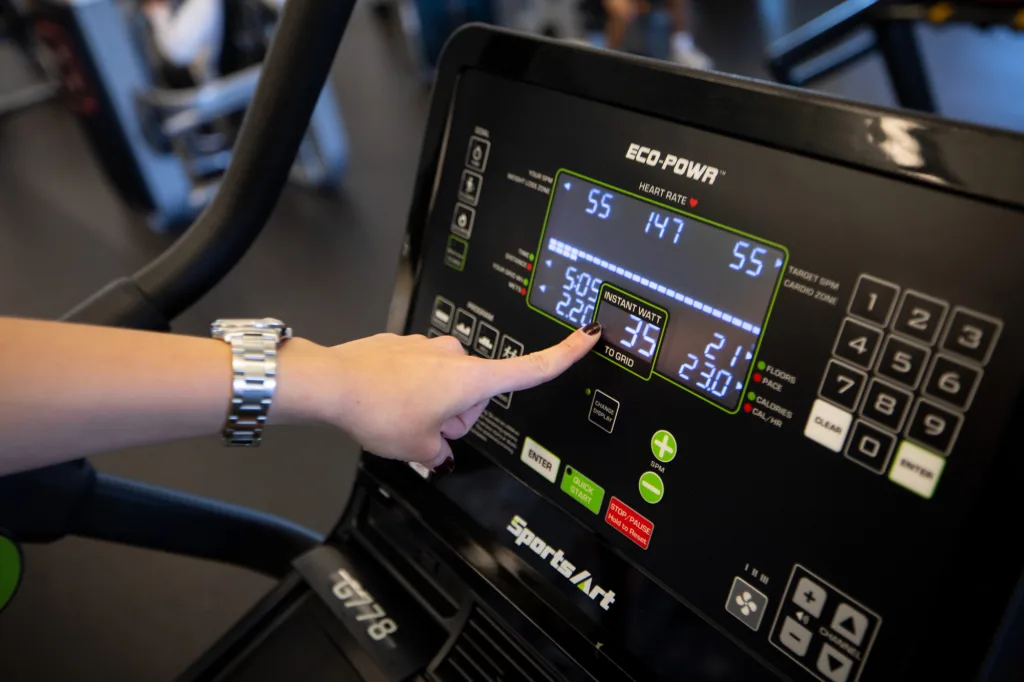When students at Brown University head to their campus fitness center and hop on a certain treadmill, they aren’t only getting in a workout. They’re also generating electricity to power the very building they’re in.
Brown’s Nelson Fitness Center recently installed a handful of cardio machines, made by the company SportsArt, that convert human energy into electricity. As students run, step, or row, the kinetic energy from their movements is fed into the building’s power system, helping to keep on its lights and even heat the fitness center’s pool.The school currently has eight such machines but will soon add 17 more.
The energy-generating gym equipment came about thanks to a student project several years before. Elina Pipa, now a rising senior at Brown who’s originally from Athens, Greece, took a class on climate solutions during her sophomore fall semester. Every week, the class studied a range of solutions, from policies like a carbon tax to technical innovations like carbon capture. At the end of the semester, they had to present a business case for their own climate solution, to be implemented in a specific place.
Pipa felt that finding a project for her hometown of Athens was a bit intangible, since it was so far away. Instead, she focused on a hyper-local setting. “The place where I felt like I could make a difference and really be passionate about implementing this project was Brown,” she says. Rather than just thinking theoretically, “I really hoped to make my pitch come true, if possible,” she adds.

In her mind, she had the image of a hamster running on a wheel to produce electricity, and wondered if there was an existing company “that actually does that and produces equipment that we can actually use.” She eventually found SportsArc, whose equipment has been used by other universities including Ohio State and York University, as well as by facilities like Monkton Stadium in England.
From there, Pipa’s project had to consider all the specifics. She spoke with the company, with athletic directors of other universities that have used the energy-generating gym equipment, and with students at Brown to survey if and how often they would actually use those cardio machines. She analyzed the electricity data from the fitness center (since it has a pool, energy is needed not just for lights and equipment but also heating and cooling), figured out the climate mitigation impact of the machines, and ran a cost-benefit analysis to figure out how much it would cost, or save, the school.
Brown’s fitness center already had solar panels, a fact that actually helped Pipa’s project. Those solar panels offset about 2% of the building’s energy demand every year. Pipa made three different scenarios for her energy-generating gym equipment solution, based on how many pieces of cardio machinery could be installed, and how much use they would get. The middle scenario, which assumed that Brown would replace half of its cardio machines with the energy-generating versions, would offset 2% of the building’s electricity—equivalent to the solar panels already in place.
“It was super exciting because you could see that there is an impact,” she says. “When you see that even your gym equipment can do something . . . you start seeing that it is possible to have habits in your life that are positive for the environment, and [that can] help push people away from some of the climate pessimism.”
Gym-goers can see that impact directly. On the cardio equipments’ panels, along with your time or mileage, the SportsArt equipment also displays the “instant watts” going to the grid based on your pace. Exactly how much you generate depends on that pace and the type of equipment itself. SportsArt says its equipment can generate up to 220 watt hours of electricity per hour of workout. In a separate test, one reporter found that 30 minutes of walking created about 80 watt hours of electricity, enough to power an LED light bulb for about six hours.

Pipa’s idea went from class project to real program with the help of her professor, Stephen Porter, who pushed her to talk to the school’s athletics department. In spring 2023, they both helped move the idea down the pipeline, and that summer, the school did its own analysis on cost and impact. Brown set up a pilot program with six pieces of energy-generating gym equipment in the fall of 2023.
Over the course of that pilot, Pipa kept track of peoples’ workout experiences through surveys, figuring out what equipment they liked using and how they compared to the traditional cardio machines. But the management of the equipment, and how much energy they generate, is now out of her hands and handled by the athletics department.
With the six-week pilot considered a success, the school is keeping the equipment in place, and even adding more. With the 17 machines the school is working to add by September, when the fall semester starts, there will be a total of 25 pieces of energy-generating gym equipment. (The school doesn’t currently have data on exactly how much total energy these machines have generated for the building, but it’s working with SportsArt to figure out how to track that.)
The fact that this gym equipment is in place after Pipa’s original class assignment—with even more machines on the way—shows, she says, that students don’t have to wait until they graduate to take climate action. It also hints at how taking care of the planet doesn’t have to be a big, life-interrupting ordeal. Instead, she says, “you can implement climate friendly options into your lifestyle very seamlessly and easily.”